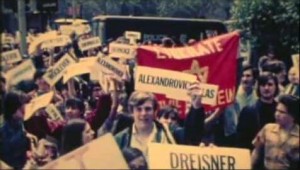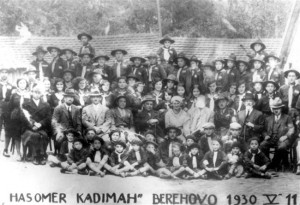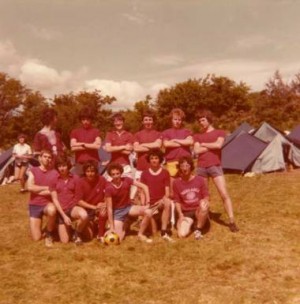Jewish Youth Activism: A Model for Leadership Development?
Looking back, I find that my years growing up in a committed Cleveland, Ohio, family coincided with the twilight of twentieth-century Jewish romanticism. I entered middle school as the struggle for Soviet Jewry paid big dividends: by the time I was in seventh grade—1992–1993—Jews by the name of Dima, Goya, Rada, and Darina filled our classrooms at Cleveland’s Schechter Day School. It was a great education in Peoplehood for a thirteen year old: there were all these Jews “out there,” utterly foreign to me, but for whom I was responsible because of the Jewish value that “all Israel is responsible for one another.” I recall one Shabbat when my parents interrupted a game to show my siblings and me pictures of them marching wearing yellow “Triple-SJ” tees. In those moments, the dwindling flames of the Soviet Jewry movement warmed a member of the next generation who would barely remember glassnost.
Nights, I’d hitch a ride to the old Sinai synagogue in Cleveland Heights to meet with members of my Zionist Youth Movement, Betar (notwithstanding its conservative ideology, a movement of largely “unaffiliated” public school kids). In a faded basement we’d debate revisionist Zionist ideology and Israeli politics until midnight. By the time I was thirteen I’d read Begin’s Revolt, Jabotinsky’s Iron Wall, memorized the poetry of Yair, read the Story of the JDL, run programs for groups of thirty to forty peers and chanichim, and done my best to get arrested protesting for Jonathan Pollard and against Oslo. After a few years of studies we’d be tested on our knowledge and skills—if we passed, we’d earn a Betar uniform and become madrichim. From our peers, our books, and our mentors, we imbibed the energy of youth, self-determination, rebellion, and responsibility. This wasn’t 1969, it was the early 90s! Out there, we knew, were Betarim who had made aliyah and joined the IDF. They were our role models idolized from afar, as most of us didn’t have the cash to visit Israel.
My experience was similar in spirit, if not in substance, to that of many other peers who were likewise engaged in Zionist, as well as the leadership of communal youth movements. While our movements’ politics and culture differed, the value underpinning our ideologies was first and foremost a personal commitment to the Jewish People’s mission, destiny, and mutual responsibility. In the service of the Jewish People we were responsible—eager—to invest time, energy, hours, money, and dreams. That was the whole Torah on one foot.
A quick scan of the Jewish professional scene today tells the story of how these youth movements translated into today’s Jewish community. The youth movement approach—focused on activism, velocity, peer leadership, education, high commitment programming, and innovation—drives some of the most innovative and creative content that we see in the Jewish world today. People like Anne Lanski at the iCenter, Aliza Mazour at Bikkurim, Justin Korda at ROI, Yoni Gordis at CLI, Scott Kaufman at the Detroit Federation, Sarah Kass at AVI CHAI, and many more Jewish activists and professionals in Israel keep the hadracha spirit flowing throughout Jewry’s enterprise. While they are a minority in a Jewish professional landscape that trends toward a more corporate type, individuals like these—many of whom sprang from movements and youth group leadership programs—are founts of creativity, commitment, innovation, and an authentic Jewish vision, i.e., real leadership.
Sadly, that movement approach to Jewish leadership development is no longer available to today’s tween and teen Jews. For a million reasons and more—including their own recklessness, changing times, and Israel’s conflicted image—the youth movements are probably not destined to return in strength during this generation. Their departure, however, has implications for the Jewish future—specifically a void in the leadership pipeline that presents a special problem as we confront today’s unprecedented challenges.
These challenges could not be more clear: when it comes to the institutions like the Federations that were designed to provide for the common welfare of the Jewish People, mainstream Jewish community support is weakening. Organizations whose donors were once driven by the presence in their midst of European or Middle Eastern/North African parents are now running on the fumes of a passion last vibrant in their donor’s grandparent’s generations. With this waning interest, the system’s very base is at risk. We all know the studies: young seek life, love, and meaning elsewhere; donor numbers are halved; commitment to and ownership of Israel devolves into confusion and grasping initiatives. There was a time where the NextGeneration felt mutual responsibility at the gut level for the Jewish People—now we are struggling to stay afloat.
Against this background, the Jewish community needs innovative responses and approaches to foster engagement in our future. The remaining establishment shops—trying to pick up the ball from the weakening movement sector, are doing their best to create large-scale leadership development initiatives. For example, in North America JFNA has pushed leadership development projects like TribeFest, #ish, and Heroes, and there have been major foundation-funded programs as well, such PLP, ROI, and similar programs operating under the extensive Schusterman umbrella. However the forms of engagement these establishment programs create necessarily will have very different characteristics from movement-based leadership development programs. Several key points come to mind:
First, leadership development in a youth movement context ensured that there was a good deal of Jewish knowledge—songs, Hebrew, history, concepts—behind the activists that sought to lead the Jews toward something important. Today, while there is enormous good will on the part of young people to be Jewish leaders, we notice that many of these individuals have little to no in-depth background in Jewish content and practice.
Second, youth movements were peer-led and peer driven (often to an irresponsible degree which led to many near- lawsuits) and kids of 10, 11, and 12 were expected to command the attention of those older than themselves in large and small groups. Today’s emerging leaders do not have this background or the toolset of icebreakers, group dynamic sensitivities, and program flow that is second nature to madrichim who went through hadracha training.
Third, a different cohort of youth are coming forward as leaders. By the late twentieth-century, youth movements were no longer mass initiatives—they were deep dives with a few thousand people per year—but those people were positioned well to be lights to the broader community. These future leaders were often “unaffiliated” types, coming from public schools, secular backgrounds, and different walks of life than those who attend dayschool, serious complimentary schools, and the camp chains. Their deep commitment to the youth movement translated into an intense desire to educate themselves about Judaism and gave them a lasting sense of responsibility to the Jewish people.
Today, however, the outreach to this unaffiliated demographic does not come from the bottom-up self-identification of passionately committed youth but from a focus by the establishment on free experiences, mass numbers, and top-down driven content. Many of us—including leaders across our establishment, many of whom grew up in the context described above—fear that the level of commitment being asked of those whom we are calling our “next generation leadership” won’t be enough to keep the lights on in twenty and thirty years.
A case in point is TribeFest, the Jewish Federation of North America’s massive and by many measures successful youth engagement blowout in Las Vegas. TribeFest (where my organization PresenTense has had representation) has a great formula for attracting young people through a mix of a hot location, fun, and networking. Program success aside, however, TribeFest’s very existence does more to highlight the utter failure of our community over the past twenty years rather than anything else I could describe.
I can comfortably say this because it is clear to me that our leadership must see the investment in TribeFest as utterly instrumental, an attempt to bring in new blood to support the community to do the important work it has always done: caring, connecting, educating, and rescuing. They cannot, in good conscience, believe that TribeFest—essentially a spring-break style fest of Jewish partying with content elements thrown in—is a worthy goal in and of itself, or that it represents or conveys the purpose of Jewish youth leadership going forward. After all, the leaders supporting TribeFest are among those who worked to support the Jewish State through thick and thin, who struggled to bring succor and welfare to millions of immigrants and war refugees during the twentieth century, and then partnered to fight for Soviet Jewry, and now raise resources to give our elderly dignity as our population ages. To think that they are declaring our crowning achievements to be a grand weekend of young people in Vegas (i.e., once upon a time, our community mobilized to drain swamps in the Galilee; in 2012 we successfully drained margaritas at the Bellagio.) would be to make a mockery of who they are and who came before them.
These incredibly committed leaders who I admire personally and professionally—mentors, advisors, friends, and heroes—are desperate to eschew parties in Vegas. They’d much rather that these young folks would commit of their own accord to participate in Jewish communal life because of its inherent value. The motivation for TribeFest comes from the desperation of the times. In the face of system failure our leadership reached out to young people, most of whom were engaged through the establishment leadership track, rather than the movement hadracha track. When asked what might work to engage, the answer they heard was: party hard in Vegas.
TribeFest and other engagement initiatives like it are not themselves the problem—we Jews have always loved to party hard and lord knows we need to engage mass numbers. The issue with TribeFest is that as a standalone strategy it will have little long-term impact on the Jewish future. Engagement without fundamental purpose, vision, and breathtaking daring will only hold fast for a short time. Moreover, to adapt Buber’s words on another subject, Engagement for Engagement’s sake is the most highly un-Jewish use of our resources that one could imagine. Engagement around explicit meaning and purpose—with good times thrown in to get people in the door—is what builds a leadership of the Jewish future.
In order to build new narratives of Jewish meaning to capitalize on TribeFests, Birthright, and others, we need to be looking for programs that truly engage youth around Jewish issues that have meaning and purpose, and teach towards extraordinary commitment to our People. The establishment—and here I look mainly to the national organizations like JFNA, JCCA, as well as some of the more institutional foundation players—must now recognize that, as “the last man standing” when it comes to serious dollars and heft, it has become responsible for investing in programs that drive and foster high levels of commitment, skills in mobilizing and leading peers, deep Jewish knowledge, and an identification with the fate and destiny of the Jewish People. They must invest in these programs even as they will likely all emerge from outside the establishment’s four walls.
We do not need to start from scratch to look for that kind of programming. High demand leadership engagement is happening all throughout the community, albeit on budgets that don’t hold a candle to TribeFest and peers. Limmud, for one, is a program that emerged outside the establishment and has developed numerous local extensions (often in partnership with local institutions). Limmud’s volunteer mobilization is significant, and individuals report being built up as Jewish leaders, gaining peer to peer leadership skills, and Jewish knowledge. Critically, Limmud is built on the basis of volunteers who engage in work that is normally, in most Jewish organizations, reserved for professionals. Here’s a program that could go even more large-scale if the established institutions backed it at a level equal to their mass engagement programs, and helped it reach more unaffiliated and underengaged.
My own organization, PresenTense, offers a mode of engagement that is about commitment, Jewish People purpose, leadership, and respectfully changing the status quo. When Ariel Beery and I spent sleepless nights in 2007 creating PresenTense’s first venture acceleration program, it was the youth movement spirit that drove our decisions. In the intervening years, that spirit has influenced every aspect of the organization. One of our key metrics is to shift as many minutes as possible from passive engagement with the Jewish community to active participation in pursuing important Jewish causes. We work hand in hand with community federations, organizations, and others, and it pays off because these institutions connect to leaders mobilized by purpose, content, and meaning, alongside fun, network, and philanthropic satisfaction.
These sort of programs demand high levels of commitment from the young people they touch: if you want in, we want many, many hours, and we want you to commit to give mindshare—buy your credibility through a combination of brains, sweat and treasure—not only treasure. Participants also asked to be true to the values that underlie our organization’s founding assumptions: to break established thought prisons, to not accept the HOWs of today’s Jewish life but instead reach for the WHYs.
Today, across our community, we ask young people to be engaged as a frame of mind, but engagement requires an object—we engage in something. My Betar peers were engaged in the problem of Soviet Jewry; we were engaged in defending our people against anti-Semitism; we were engaged in supporting Israel. We believed passionately in Jewish mutual responsibility. We were ideological, and our activities were in support of that ideology.
In the globalized, multicultural world of the twenty-first century, Jewish Peoplehood has an alien ring. Nor is Israel swallowed straight, an easy flag to wave for our less than nationalist times. The desire to participate in the Jewish world is still there, but without an ideological push, the passion is gone. Ultimately, our future will depend on empowering thousands of micro-narratives of Jewish meaning and seeing which of them takes root and grows followers. Let each—and they’ll be around environmentalism, learning, education, technology, Israel, culture, social justice, etc.—vie for attention in a market of passionate young Jews. Some of these narratives will take root and flourish, and start to draw from those on the outside who are of course linked with those in the inside. Others will fade away. What’s important is to build the framework to let these new narratives take root, flourish and do the work of engaging thousands. From there, the People will take up the right flags.
For the Jewish community, programs like PresenTense, as well as others such as Hazon and Limmud, will offer less flash and instant bang for the buck than TribeFest or Birthright. This style of organization is by definition not flashy—it’s based on the model of community organizing, building person-by-person, venture by venture (and in many ways we learn from local Federations’ models of engagement). We work slowly until we have a model, and then scale. We build a new Jewish narrative piece by piece, individual by individual.
If we can achieve this, the committed core will be able to draw in thousands on the strength of their vision and mission. They will be the engine to realize the mass engagement potential of initiatives like TribeFest. The answer to what will engage a new generation will come from those who have the willingness to commit, and the spirit to fight for the next path for the community.
I hope funders and community leaders will begin to look for these kinds of programs, initiatives, and frameworks—educational and otherwise—that let Jewish youth locate the kind of meaning that leads to authentic committed and longterm engagement. Invest heavily. Double, triple, the budgets and energy in these types of programs, in order to insure that the big bang fests, summits, and epic web campaigns, aren’t driving straight off a cliff. Expect messy results—venture capitalists, after all, expect only 30% of the initiatives they fund to make headway. Whatever the risk, if we invest in these frameworks, eventually we’ll have the mass of champions that will bring us to the win. If we do this, we will see what a mobilized Jewry can do for the People and Purpose we all hold dear.
![[the current issue of ZEEK]](../../image/2/100/0/5/uploads/leftistethicistgraphic-52842c6a.png)
- 5000 Pages of Zeek
- Founded in 2001, Zeek was the first Jewish online magazine, and we have over 5000 pages online to prove it, all available free of charge. Read more in the Archive.
More articles in
Life and Action
- Purim’s Power: Despite the Consequences –The Jewish Push for LGBT Rights, Part 3
- Love Sustains: How My Everyday Practices Make My Everyday Activism Possible
- Ten Things You Should Know About ZEEK & Why We Need You Now
- A ZEEK Hanukkah Roundup: Act, Fry, Give, Sing, Laugh, Reflect, Plan Your Power, Read
- Call for Submissions! Write about Resistance!





